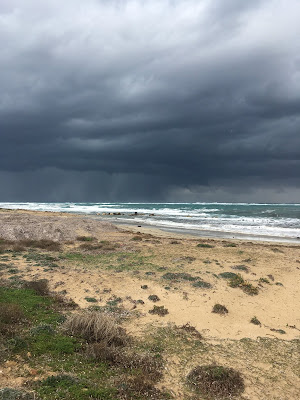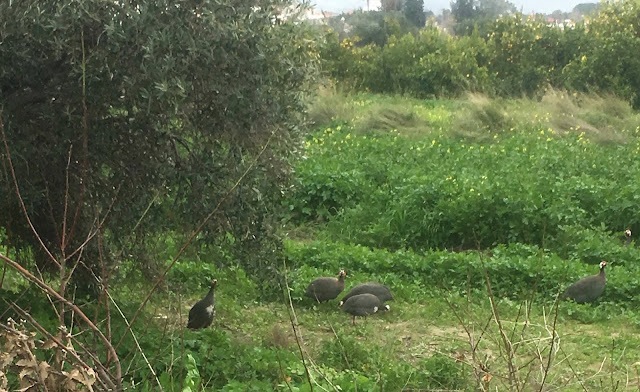 Although Britain left Cyprus in 1960 seems like Britain did not completely leave. Cyprus appears to have inherited the English language (a fair amount of English speaking Cypriots), driving on the left side of the street and the distinct electrical plugs requiring bulky adapters. Britain seems to have lingered on in the west Cyprus town of Paphos, as almost everyone we’ve heard on the street has an English accent.
Although Britain left Cyprus in 1960 seems like Britain did not completely leave. Cyprus appears to have inherited the English language (a fair amount of English speaking Cypriots), driving on the left side of the street and the distinct electrical plugs requiring bulky adapters. Britain seems to have lingered on in the west Cyprus town of Paphos, as almost everyone we’ve heard on the street has an English accent. The streets in Paphos are filled with English specialty shops, betting parlors, pubs and restaurants offering full English breakfasts. The pubs show English football leagues on big screen TV's.
Walking along the beach promenade almost felt like being on the North Sea coastline, again, but with a bit more sun; https://thechosenfugue.blogspot.com/search/label/Scarborough , https://thechosenfugue.blogspot.com/search/label/Eastbourne
 While Kyrenia in the North also seemed to be a haven for British ex-pats, we did hear a lot of Russian mixed in with Turkish ( https://thechosenfugue.blogspot.com/search/label/Nicosia). Cyprus gets about 3 million tourists a year. 1.2 million from the UK, then 800,000 from Russia, so 2/3’s of the tourists are from just these 2 countries. Israel is third but with only a ¼ million visitors a year. The US is not even in the top 10. Cyprus also seems to welcome ex-pats, with housing developers advertising that a condo purchase is enough to earn you Cypriot (and EU) citizenship.
While Kyrenia in the North also seemed to be a haven for British ex-pats, we did hear a lot of Russian mixed in with Turkish ( https://thechosenfugue.blogspot.com/search/label/Nicosia). Cyprus gets about 3 million tourists a year. 1.2 million from the UK, then 800,000 from Russia, so 2/3’s of the tourists are from just these 2 countries. Israel is third but with only a ¼ million visitors a year. The US is not even in the top 10. Cyprus also seems to welcome ex-pats, with housing developers advertising that a condo purchase is enough to earn you Cypriot (and EU) citizenship. Paphos definitely tempts with it's mix of cheesy tourist area with themed bars
 |
| Yet another Flintstones themed bar, confirming that the Flintstones were originally from Cyprus |
modern town with shopping mall (hello Taco Bell!-although it was very disappointing),
and ancient ruins with beautiful mosaics.
Paphos kind of has a Disneyland of Ruins, the Archaeological Park and down the road from that the Knott’s Berry Farm of Ruins, The Tomb of the King. Our first attempt to go to the Archaeological Park was rained out with a very painful hail storm but the next day the sun was back out.
The park was essentially ruins of the posh part of the original town, 2nd-4th AC; an amphitheater, palace and homes. Striking ruins with beautiful mosaics although, many of the mosaics were unfortunately purposely covered with sand and tarps- they still had the educational placards describing them.
We figured it was to protect from winter rains, and asked but the visitor center guide was the least informed person at the Park that day, shrugging her shoulders and saying "I don’t know" when we asked a question that’s surely been asked thousands of times. The mosaics that were exposed, roofs protected these, were enough, though.
One of the great things about wandering, is stumbling across amazing places like this church from the 2nd century AD.
Not only were there wonderful mosaics (from the 4th Century) but this church also had St. Paul’s pillar where he was apparently lashed 39 x’s, impressing the King enough for the king to convert.
Apparently then they celebrated at St. Pauls’s Pillar Pub next door.
Without drinking, we also (literally) fell into the St. Solominus Catacombs. Underground shrine with deep caverns with steps leading down into an unseen pool of water, baptizing Nick’s feet.
 This may have been one of our favorite spots in Cyprus. Good story, Jewish/Catholic/Pagan history- this is thought to have been a synagogue, converted to a church in the 9th century. It is the burial cite of the Jewish Maccabee brothers killed by the Romans for being Jewish. One story says the king asked them to eat pork and they refused saying they would rather die. Another story says they refused to worship idols and were killed. Their mother, Solomini became a Christian and one story says she was locked up in the catacombs and two hundred years came out alive. In addition to these stories, people tie ribbons and rags (Pagan ritual) to the tree growing out of the catacombs to be cured of ailments. As we approached, we saw two young men in track suits, deep in discussion, pause, kiss the tree and then continue their discussion.
This may have been one of our favorite spots in Cyprus. Good story, Jewish/Catholic/Pagan history- this is thought to have been a synagogue, converted to a church in the 9th century. It is the burial cite of the Jewish Maccabee brothers killed by the Romans for being Jewish. One story says the king asked them to eat pork and they refused saying they would rather die. Another story says they refused to worship idols and were killed. Their mother, Solomini became a Christian and one story says she was locked up in the catacombs and two hundred years came out alive. In addition to these stories, people tie ribbons and rags (Pagan ritual) to the tree growing out of the catacombs to be cured of ailments. As we approached, we saw two young men in track suits, deep in discussion, pause, kiss the tree and then continue their discussion.
Not only were there wonderful mosaics (from the 4th Century) but this church also had St. Paul’s pillar where he was apparently lashed 39 x’s, impressing the King enough for the king to convert.
Apparently then they celebrated at St. Pauls’s Pillar Pub next door.
 |
| Who knew there was a sacred spring here? |
 This may have been one of our favorite spots in Cyprus. Good story, Jewish/Catholic/Pagan history- this is thought to have been a synagogue, converted to a church in the 9th century. It is the burial cite of the Jewish Maccabee brothers killed by the Romans for being Jewish. One story says the king asked them to eat pork and they refused saying they would rather die. Another story says they refused to worship idols and were killed. Their mother, Solomini became a Christian and one story says she was locked up in the catacombs and two hundred years came out alive. In addition to these stories, people tie ribbons and rags (Pagan ritual) to the tree growing out of the catacombs to be cured of ailments. As we approached, we saw two young men in track suits, deep in discussion, pause, kiss the tree and then continue their discussion.
This may have been one of our favorite spots in Cyprus. Good story, Jewish/Catholic/Pagan history- this is thought to have been a synagogue, converted to a church in the 9th century. It is the burial cite of the Jewish Maccabee brothers killed by the Romans for being Jewish. One story says the king asked them to eat pork and they refused saying they would rather die. Another story says they refused to worship idols and were killed. Their mother, Solomini became a Christian and one story says she was locked up in the catacombs and two hundred years came out alive. In addition to these stories, people tie ribbons and rags (Pagan ritual) to the tree growing out of the catacombs to be cured of ailments. As we approached, we saw two young men in track suits, deep in discussion, pause, kiss the tree and then continue their discussion.  |
| Offerings and remnants of 12th Century frescos |
We walked pathways along the beach, from one end of Paphos to the other as well as along the the beach in Polis a small town we also visited just north of Pathos in the Akamas pennisula. On either side of the town of Pathos are massive hotels (south end) or housing and hotels (north end) . The hotel and beach condo/resorts were mostly deserted for the off season with the exception of the contingent of zombie like British pensioner couples combing the beaches, Russians using the outdoor exercise equipments and the ubiquitous cats.
Polis is not as developed as Pathos, a lot of condos but not the big hotels. The bus between Pathos and Polis went through winding narrow mountain roads thru small villages to the Akamas penisula where Polis is. The villages looked like Hollywood back lots of mountain villages with the back drop of beautiful lush green fields on sloping foothills of the Troodos mountains. These towns are apparently almost as deserted as a Hollywood set after hours, natives have mainly left and the old houses are holiday homes. Polis in Greek means city, so the town of Polis is aptly named as it felt kind of like a generic Cyprus town with non-distinct small commercial area, an “authentic” 2 block tourist area (which was fairly nice, small restaurants, souvenir and clothing stores plus a 115 year old simple stone church).
 The draw here is the Baths of Aphrodite-if you bathe in it, you receive everlasting beauty, just like Aphrodite. However, to discourage this they have stocked the pond with creepy freshwater eels-which we saw. Everlasting beauty comes with a risk of feeling eel. After visiting the baths, we walked up the Aphrodite Trail, apparently as she did after her bath (early Spa treatment?).
The draw here is the Baths of Aphrodite-if you bathe in it, you receive everlasting beauty, just like Aphrodite. However, to discourage this they have stocked the pond with creepy freshwater eels-which we saw. Everlasting beauty comes with a risk of feeling eel. After visiting the baths, we walked up the Aphrodite Trail, apparently as she did after her bath (early Spa treatment?). Looking down at her beach, we thought this was Aphrodite’s rock where she was born arising out of the sea, but apparently she had her water birth (sea section?) closer to Limassol, but we took lots of pictures of this rock so didn’t want to waste it.
But the most exciting thing was seeing the wild goats climbing trees.
 |
| Highlights magazine: find the hidden goats |
We generally have not seen many animals (other then cats). Once we saw a handful of Comorants (see pic above) but generally just crows, pigeons, doves and of course cranes
Then we stumbled on the helmeted guinea fowl
 So Paphos and surroundings delivered. From the lovely place we stayed (and added on 3 days), the great supermarket with live snails in the produce department, to the really beautiful beaches.
So Paphos and surroundings delivered. From the lovely place we stayed (and added on 3 days), the great supermarket with live snails in the produce department, to the really beautiful beaches. This week's photo of a topless old man looking out window contemplating his life...
"just saw his shadow, which means another six weeks of Seasonal Affective Disorder"














































